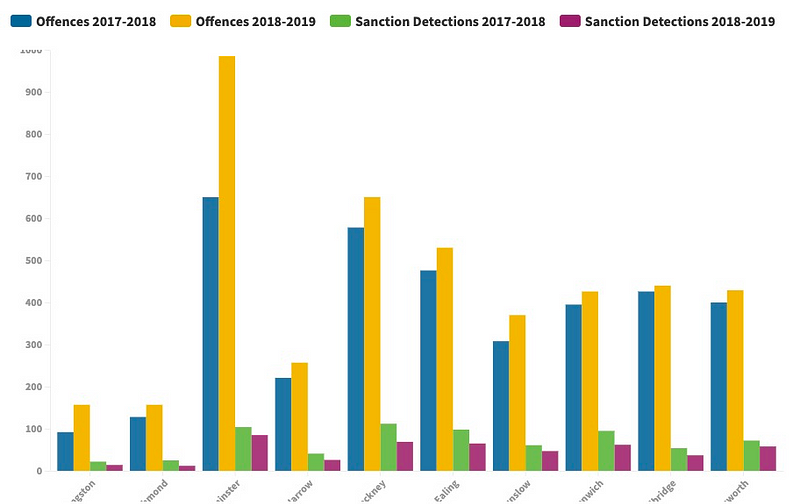Rise in knife crime and drop in Sanction Detections in the top 10 UK Boroughs
Rise in knife crime and drop in Sanction Detections in the top 10 UK Boroughs
By Sergio M. and Subeer S.
Ten boroughs in London were identified as those with the biggest gap between knife crimes risen and sanctions detentions, comparing the last two years (2017–18 and 2018–19), these kind of crimes have increased considerably in these boroughs, but at the same time, the detention rates have dropped substantially, according to an analysis of the Metropolitan Police Records.
Some of the boroughs on the list are Westminster, where knife crime rates increased in 51.5% but its sanction detection rates decreased 18.3%. Another Borough with concerning figures is Kingston upon Thames, where the crimes rose in 70.6%, while the sanction detection dropped in 36.4%. You can find the data about the other eights boroughs in the following chart.

However, these 10 boroughs with the biggest gap between offences and resolved crimes are not the most dangerous, except for Westminster, that actually is the one where most knife attacks were registered: 985. Below this one are Southwark (777), Haringey (764), Newham (696), Brent (680), Tower Hamlets (667) and Hackney (650).
On the other hand the boroughs with less knifes crimes identified are : Heathrow Airport (2), Sutton (148), Richmond upon Thames (157), Kingston upon Thames (157), Bexley (188), Merton (220) and Bromley (230).
In October of this year, Met Police Commissioner, Cressida Dick, explained that to deal with knife crime was the first priority. According to a BBC article, these types of crime have increased in 2019 to at least 80% from 2014, when the lower point was reached. At the same time, the number of knife-related homicides reached almost 300 in 2017, the highest point in the last 40 years registered.
Even when these offences are being committed all over the UK, London is still the city where most crimes are being detected.
This concerning situation, especially in those cases where the crimes increased and the resolved cases decreased, could be explained by different reasons. There have been studies suggesting that the cuts in the funding for the Police and youth services don’t help in the strategy to reduce knife crimes. Actually, a consequence of these cuts is the transition of the 32 commands, centred around local authority boroughs, towards 12 Basic Command Units (BCU), which will combine two or more boroughs due to limited resources.
Others pointed out to drug trade, gang’s rivalries, and immigration from countries with high level of violence and insecurity.



Comments
Post a Comment